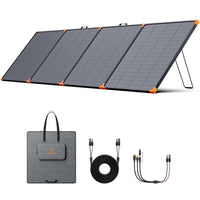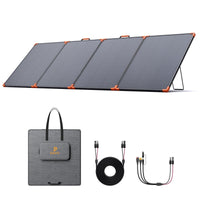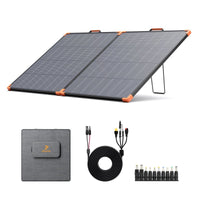How many solar panels to power a house? A 2025 Guide
As solar energy becomes more accessible and affordable, many homeowners are asking a crucial question: How many solar panels do I need to power my house? The answer depends on factors like your energy usage, your location, and the type of solar panels you choose. In this guide, we’ll walk you through the essentials of calculating your solar needs and understanding the potential costs and savings in 2025.

🔋 What Is a Kilowatt-Hour (kWh)?
A kilowatt-hour (kWh) is a measurement of energy use. If you use one 1,000-watt appliance for one hour, that equals 1 kWh. Most U.S. homes consume around 877 kWh per month, according to the U.S. Energy Information Administration (EIA).
To calculate how many solar panels you need, you’ll need to understand how much energy you use and how much your panels will produce.
☀️ How Much Energy Does a Solar Panel Produce?
The output of a solar panel depends on:
-
Wattage of the panel (e.g., 400W)
-
Average peak sun hours per day (varies by state)
-
System efficiency (typically ~85%)
Daily Output Formula:
Panel Wattage × Sunlight Hours × 0.85 = Daily kWh
Example:
400W × 6 hours × 0.85 = 2.04 kWh/day
That means each 400W panel produces approximately 60–65 kWh per month in sunny regions.
🌎 Sunlight Hours by Region (U.S. Average)
| Location | Avg Sun Hours/Day | Monthly Output (400W Panel) | Suggested Panel Count (30kWh/day home) |
|---|---|---|---|
| California | 6.5 | ~79 kWh | 12–14 panels |
| Texas | 6.0 | ~76 kWh | 13–15 panels |
| Florida | 5.5 | ~70 kWh | 14–16 panels |
| New York | 4.0 | ~51 kWh | 18–22 panels |
🏠 How Many Panels Do I Need to Power a House?
Let’s say your home uses 900 kWh per month. Using a 400W panel that produces 60–75 kWh/month:
900 ÷ 65 = ~14 panels needed
Most American households need between 15–25 panels, depending on efficiency and location.
💰 What Is the Cost of a Solar System in 2025?
| System Size | Before Tax Credit | After 30% Tax Credit |
| 6kW | $15,000–$18,000 | $10,500–$12,600 |
| 8kW | $20,000–$24,000 | $14,000–$16,800 |
| 10kW | $25,000–$30,000 | $17,500–$21,000 |
DIY solar systems cost less—around $1.00–$1.50 per watt—if you install the components yourself.
🛠️ How to Estimate Solar Panel Needs
-
Check your monthly energy bill for average kWh usage.
-
Divide monthly use by panel output to find how many panels you need.
-
Consider future upgrades like EVs or battery storage.
-
Factor in roof space and budget.
🔌 ZOUPW Recommendation: Portable Options

ZOUPW offers N-Type portable solar panels with up to 25% efficiency, perfect for backup or off-grid power. They are foldable, easy to set up, and ideal for emergencies, RV travel, or weekend retreats.
If you're not ready for full rooftop solar, start with a ZOUPW portable solar panel to power your essentials or supplement your home's energy needs.
✅ FAQs
Q: How much energy does a solar panel produce per day?
A 400W panel can produce 1.5–2.5 kWh/day depending on sun exposure and weather.
Q: How many kWh does a 400W panel produce per month?
On average: ~60–75 kWh in sunny regions.
Q: How long until I break even on solar?
Most homeowners see ROI in 6–10 years, with tax credits accelerating payback.
Q: Can I install solar myself?
Yes—DIY kits like ZOUPW’s portable solar options are beginner-friendly and cost-effective.
🧭 Final Thoughts
In 2025, going solar is no longer just an eco-choice—it’s a smart investment. With proper planning, understanding your power needs, and choosing high-efficiency panels like ZOUPW’s, you can cut energy bills and build energy independence. Whether you’re powering a shed, a cabin, or your entire home, solar puts the control in your hands.
Ready to calculate your setup? Contact us or browse our high-efficiency portable panels to get started!
Share



